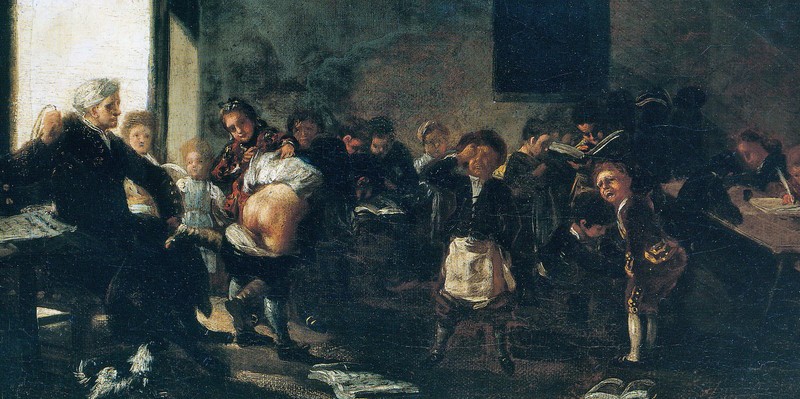- Cronología
- Ca. 1780 - 1785
- Ubicación
- Museum of Zaragoza, Zaragoza, Spain
- Dimensiones
- 19.7 x 38.7 cm
- Técnica y soporte
- Oil on canvas
- Reconocimiento de la autoría de Goya
- Undisputed work
- Titular
- Government of Aragon
- Ficha: realización/revisión
- 26 Apr 2010 / 12 Dec 2024
- Inventario
- (54385)
REGINA MARTIRUM (on the canvas, only visible by x-ray). This inscription shows that this painting was made on a recycled canvas which must previously have been used for a sketch or preparatory work for the Regina Martirum cupola in the Basilica of Our Lady of the Pillar, in Zaragoza.
During the 19th century this painting was housed in the church of San Ildefonso (San Ildefonso-La Granja). In around 1920 it entered the Rosillo collection in Madrid, until finally being acquired by the Aragonese regional government in 2008.
From December 5th, 2024, and while the Zaragoza Museum remains closed for works, the painting is part of the exhibition 'Goya. From the Museum to the Palace' in the Aljafería Palace in Zaragoza.
In thematic and chronological terms, this work is related to the Children's Games series of paintings , Children playing children, Children Playing on a See-Saw, Children Fighting Over Chestnuts, Children Looking for Nests, Children Playing Leapfrog , Children Playing at Bullfighting. On the left-hand side of the canvas we see a teacher sitting in a large armchair whilst he strikes a student across the backside with a whip. On the right, other children are crying as they tidy up their clothing, obviously having just received this same punishment themselves. Behind them, the rest of the students are busily studying, either reading or writing, their diligence probably inspired by a fear of receiving the same chastisement as their classmates. The light coming through the window on the left-hand side falls selectively on the teacher and on the reddened buttocks of the pupil, leaving the rest of the scene in relative darkness.
In this painting, Goya denounces the precarious state of child education in Spain, just as he would later do again in a number of etchings in his Caprices series (nos. 3, 4, 25, 79 and 80). The little dog which he has painted below the schoolmaster is an allusion to submission, the attitude adopted by the children in the background as they go about their work in silence. The picture also makes reference to the lack of resources in the school, since the students are shown sharing books, and to the fact that education was something to which only the higher social classes enjoyed access, as demonstrated by the clothing of some of the students in this scene.
Goya may have been influenced by the painting by Michel-Ange Houasse (Paris, 1680-Arpajon, 1730) entitled Interior of a School (El interior de una escuela), painted for the Royal Palace of La Granja.
-
Goya e ItaliaMuseo de ZaragozaZaragoza2008organized by the Fundación Goya en Aragóna, consultant editor Joan Sureda Pons. From June 1st to September 15th 2008cat. 246
-
Goya y el Mundo ModernoMuseo de ZaragozaZaragoza2008organized by the Fundación Goya en Aragón at the Museo de Zaragoza, consultant editors Valeriano Bozal and Concepción Lomba Serrano. From December 18th 2008 to March 22nd 2009cat. 23
-
Madrid2017
-
Hamburg2019cat. 36
-
Goya. From the Museum to the PalaceZaragoza2024cat. 39
-
Goya: etude biographique et critique suivié des catalogues completsParísLibrarie de l'Art Ancien et Moderne1902nº 62, p. 110
-
La época de GoyaMadridCalleja1924p. 305, fig. 84
-
Vie et ouvre de Francisco de GoyaParísOffice du livre1970p. 90, cat. 159 a
-
BarcelonaPolígrafa1970vol. I, p. 265, cat. 189
-
L’opera pittorica completa di GoyaMilanRizzoli1974p. 98, cat. 143
-
Goya. Nuevas visiones. Homenaje a Enrique Lafuente FerrariMadridFundación Amigos del Museo del Prado1987p. 235
-
Goya e Italia, 2 vols.ZaragozaFundación Goya en Aragón y Turner2008vol. I, p. 171, Vol. II, pp. 283 y 284,
-
Goya y el Mundo ModernoZaragozaFundación Goya en Aragón y Lunwerg2008p. 126 (il.), cat. 23
-
ZaragozaGobierno de Aragón y Fundación Bancaria Ibercaja2017p. 186
-
HamburgHirmer2019p. 248
-
Goya. From the Museum to the PalaceZaragozaZitro Comunicación2024p. 39
